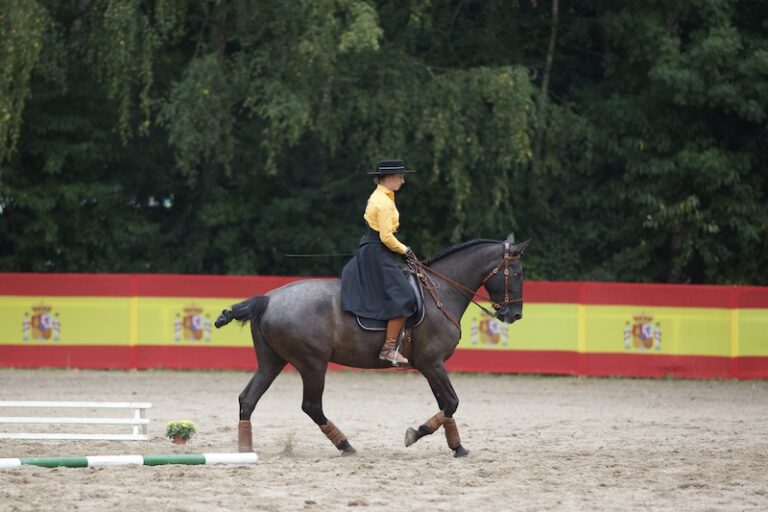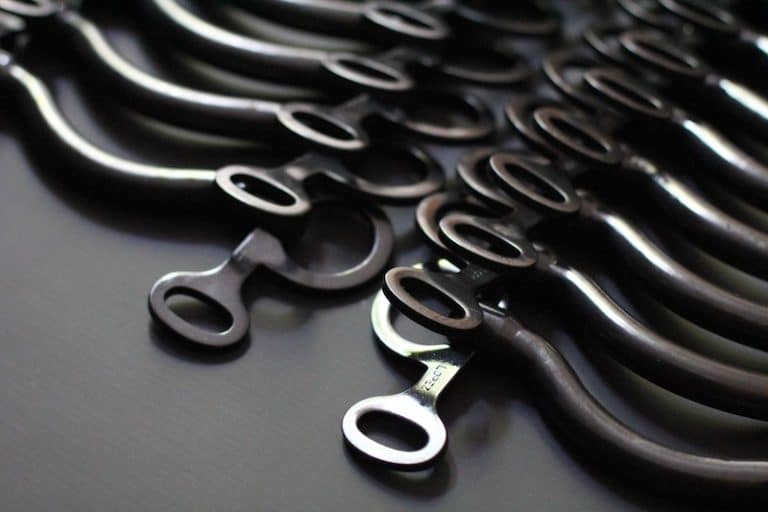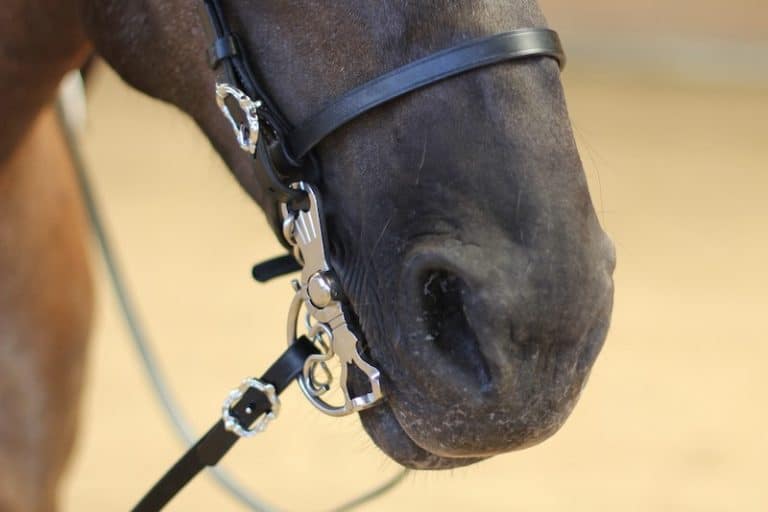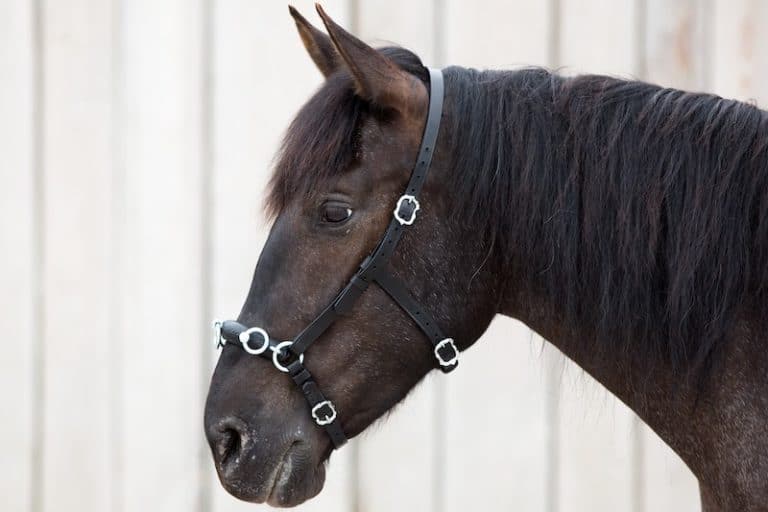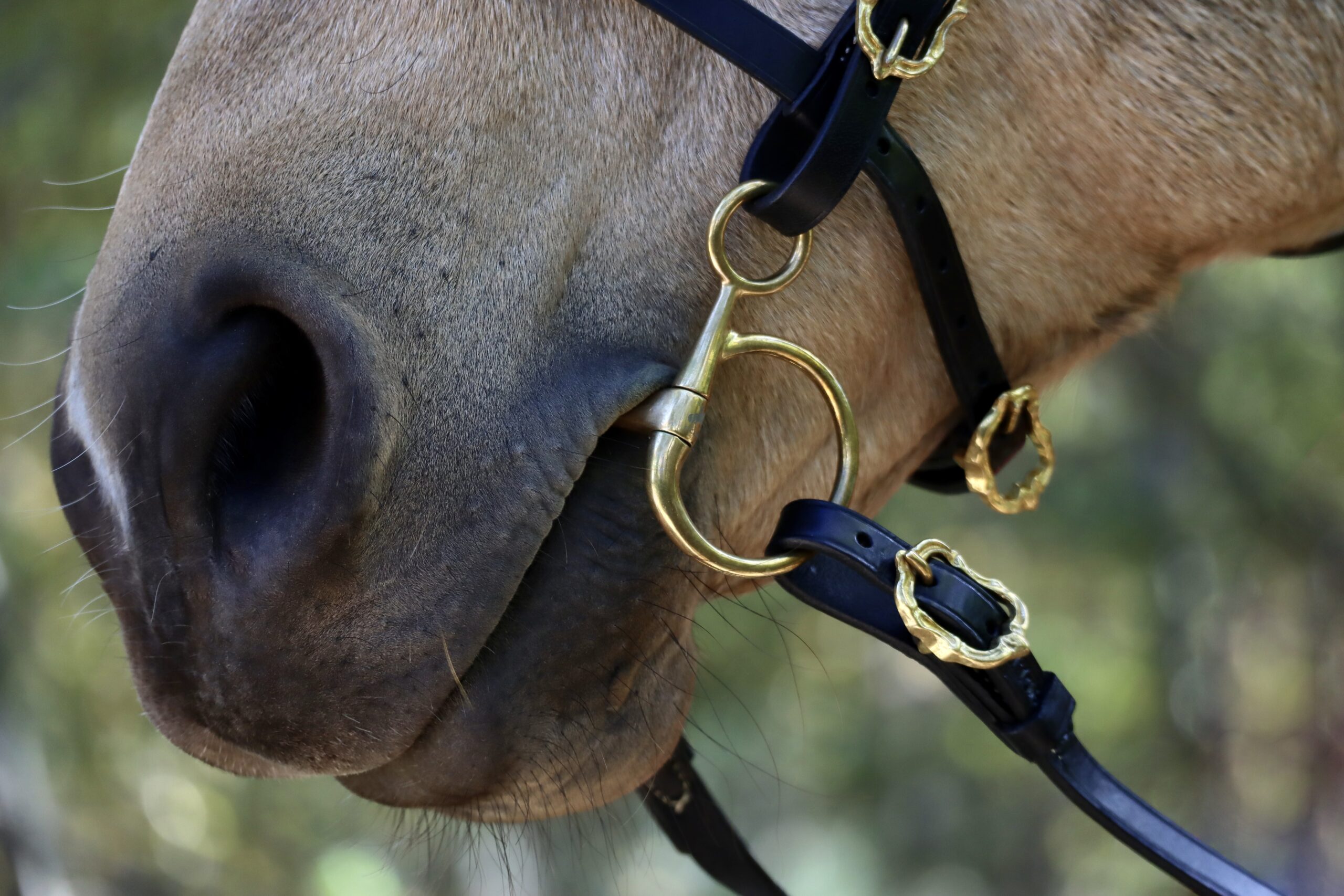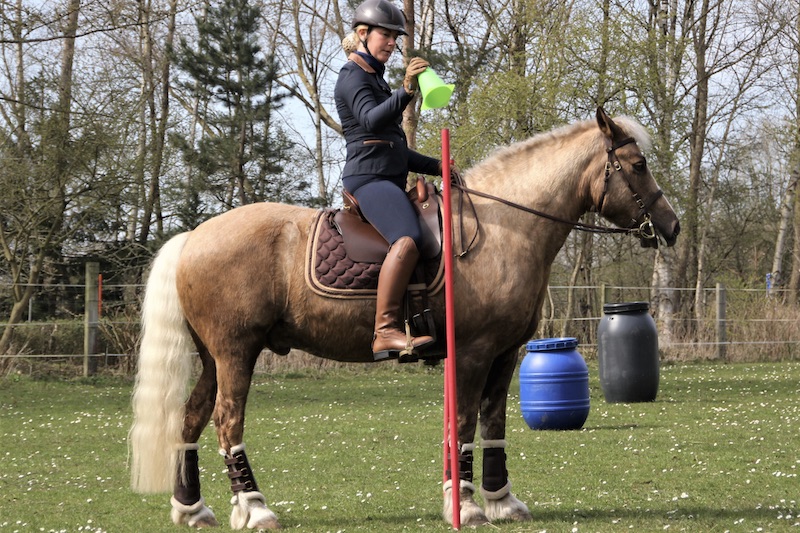Hier erfährst du mehr über den Newsletter und die Gutscheinbedingungen. Mit deiner Anmeldung stimmst du unseren Datenschutzbestimmungen zu.
Der Einstieg in die Kandare – so gelingt die Umstellung deines Pferdes auf das neue Gebiss
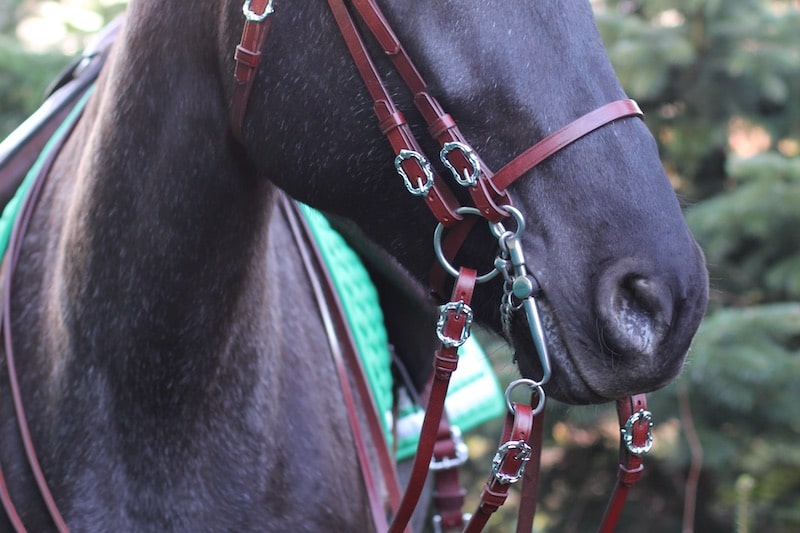
Nicht ohne Grund ist die Umstellung von der Trense zur Kandare mit Respekt und Vorsicht anzugehen. In der Ausbildung Deines Pferdes ist dies ein großer Schritt, welcher nicht nur Dein Pferd schnell überfordern kann. Lektionen, die bis dahin leicht gelangen, werden plötzlich zur Herausforderung. Dieser Beitrag soll Dir dabei helfen, dass der Umstieg auf das Stangengebiss gelingt und Du häufige Fehler vermeiden kannst.
Inhalt:
- Kandare – wie sieht sie aus, wie wirkt sie?
- Wann sind wir soweit? – Die Kandarenreife
- Die Gewöhnung – dem Pferd Zeit lassen
- Aus 2 mach 4 – Mögliche Zügelführungen für Kandare und Unterlegtrense
Hier erfährst du mehr über den Newsletter und die Gutscheinbedingungen. Mit deiner Anmeldung stimmst du unseren Datenschutzbestimmungen zu.
✓ 10 € Willkommens-Gutschein
✓ Exklusive Rabatte
✓ Updates zu neuen Produkten
✓ Tutorials + Anleitungen
✓ Nicht zu viele Emails 🙂
[mo-optin-form id=“EBhcNsBFFZ“]
Hier erfährst du mehr über den Newsletter und die Gutscheinbedingungen. Mit deiner Anmeldung stimmst du unseren Datenschutzbestimmungen zu.
Kandare – wie sieht sie aus, wie wirkt sie?
Eine Kandare ist ein ungebrochenes Mundstück mit Zungenfreiheit. Diese kann in der Ausprägung variieren. Das Stangengebiss hat links und rechts Querschenkel, welche außerhalb des Pferdemauls liegen. An den Oberbäumen wird der Zaum befestigt. Daran befinden sich außerdem die Haken für die Kinnkette. Die Kinnkette verläuft in der Kinngrube des Pferdes und macht die (teils enorme) Hebelwirkung dieser Zäumung möglich. An den Unterbäumen, besser bekannt als Anzüge, werden die Zügel befestigt. Häufig wird die Kandare mit Unterlegtrense genutzt. Seltener setzt man sie blank ein, beispielsweise in den höheren Klassen der Working Equitation.
Die Kandare wirkt auf dreifache Art:
- Druck auf das Maul in Richtung der Reiterhand
- Hebelwirkung auf das Genick über den Zaum
- Druck zwischen Mundstück und Kinnkette auf Unterkiefer und Kinn
Die Intension der Wirkung ist anhängig von:
- der Stärke der Stange
- der Ausprägung und Form der Zungenfreiheit
- der Länge der Querschenkel bzw. deren Verhältnis zueinander
- der Einstellung der Kinnkette
Die Stangenstärke kann je nach Modell und Hersteller variieren. Du solltest die Stärke (und Breite) den anatomischen Bedürfnissen und Vorlieben Deines Pferdes anpassen. Manche bevorzugen ein dünneres Mundstück, dass weniger Raum im Pferdemaul einnimmt. Falls Du das Gefühl hast, Dein Pferd fühlt sich nicht wohl mit dem gewählten Modell, teste verschiedene Stärken, um das passende zu finden. Auch die Unterlegtrense muss noch untergebracht werden, was den zur Verfügung stehenden Platz zusätzlich einschränkt. Die Breite der Stange sollte etwa 0,5 bis 1 cm geringer sein, als die Unterlegtrense, da sie sich an einer schmäleren Stelle des Mauls befindet.
Falls du unsere Stangengebisse, wie Barockkandaren, spanische Kandaren oder Pumpkandaren, blank verwenden möchtest, empfehlen wir dir die gewohnte Größe zu wählen – und nicht kleiner! Vielen Kund*innen, die sich nicht ganz sicher waren, hat es geholfen, ihr vorhandenes Gebiss auszumessen. Den Wert kannst du dann mit den Abmessungen in der Größenhilfe (zu finden bei jedem unserer Gebisse) abgleichen.
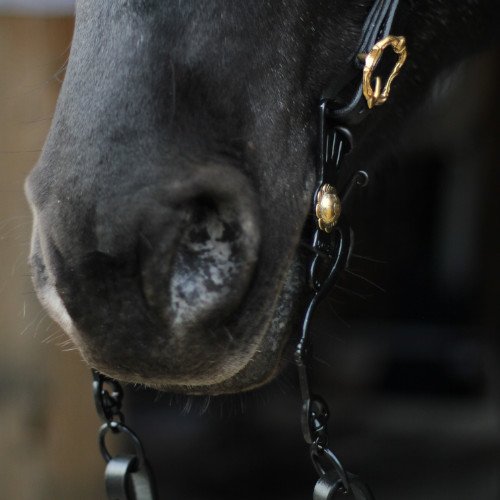
Das Wort „Zungenfreiheit“ ist in Bezug auf die Kandare eher irreführend. Denn je ausgeprägter die Zungenfreiheit, desto schärfer ist die Wirkung. Durch das Annehmen des Zügels verändert sich die Position im Maul und die Zungenfreiheit kann auf die Zunge oder gegen den Gaumen drücken. Die anatomischen Gegebenheiten Deines Pferdes spielen auch hier eine große Rolle, dass solltest Du bei der Auswahl berücksichtigen. Hat es eine dicke, eher fleischige Zunge und wie viel Raum bietet der Gaumen?
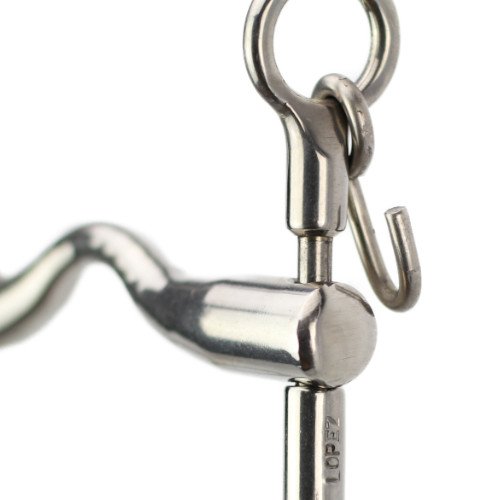
Die Länge der Anzüge beeinflusst die Stärke der Hebelwirkung. Je länger der Anzug, umso heftiger der Hebel. Kurze Anzüge vermitteln zwar einen harmloseren Eindruck, wirken aber direkter und ggf. auch härter.
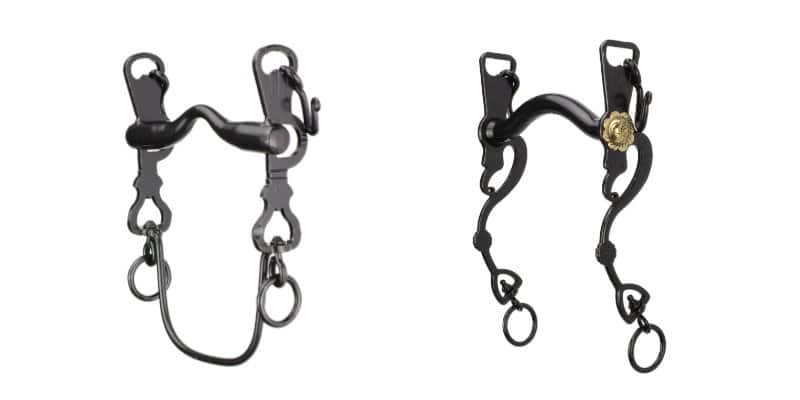
Rechts: Barockkandare mit einem Verhältnis von 1/2,4
Das Wichtigste beim Verschnallen der Kinnkette ist, dass sie korrekt ausgedreht und passend eingestellt ist. Sie liegt in der Kinngrube des Pferdes und sollte nicht zu eng, aber auch nicht zu locker sitzen. Bei angenommenem Zügel sollte die Kandare ungefähr im 45° Winkel zum Pferdemaul stehen. Damit die Kette nicht unangenehm drückt oder wenn Dein Pferd eine empfindliche Haut hat, kann eine weiche Kinnkettenunterlage oder eine Lederummantelte Kinnkette verwendet werden.

Die Zügelpaare unterscheiden sich in Breite und Verarbeitung. Der Kandarenzügel ist schmaler und am Ende vernäht. In der Regel ist er mit einem beweglichen Stopper/ Schieber versehen, um die Zügel auf eine bestimmte Länge einzustellen.
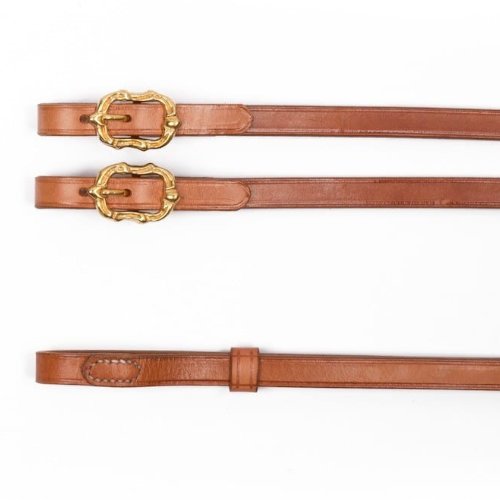
Der Trensenzügel hingegen ist meist breiter und an den Enden mit der herkömmlichen Schnalle verbunden. Falls Du kleine Hände hast, probiere aus mit welchen Zügeln du zurechtkommst, ohne ein Platzproblem zu bekommen.
Wann sind wir soweit? – Die Kandarenreife
Bevor Du beginnst, Dein Pferd auf Kandare zu reiten, sollten gewisse Voraussetzungen vorliegen. Sonst mutiert sie schnell zu einem Folterwerkzeug, welches im schlimmsten Falle enormen Schaden anrichten kann. Darüber solltest Du Dir jederzeit im Klaren sein und genau hinterfragen, ob ihr als Team schon soweit seid.
Hier einige Anhaltspunkte zur Orientierung:
- Grundvoraussetzung sollte ein respektvoller und bedachter Umgang mit dem Pferd sein
- Der Reiter/die Reiterin sollte mit der Verschnallung und Wirkung der Kandare vertraut sein
- Die Reiterhand darf nicht unruhig sein oder heftige Zügelhilfen einsetzen (gefühlvolle Einwirkung)
- Der Reiter/die Reiterin sollte zügelunabhängig nur durch den Sitz in der Lage sein auf das Pferd einzuwirken und das in allen Grundgangarten (unabhängiger Sitz)
- Das Pferd muss sich mit Gewicht- und Schenkelhilfen abwenden lassen
- Es darf sich nicht auf die Reiterhand stützen, weil es noch nicht ausbalanciert ist
- Die bisherigen Lektionen sollten in guter Selbsthaltung mit leichter Anlehnung auf Trense gelingen
- Es sollte bereits erste Ansätze zur Versammlung zeigen
- Losgelassenheit, Trag- und Schubkraft sollten ausreichend entwickelt sein
- Das Pferd sollte genügend Zeit bekommen, das neue Gebiss kennen zu lernen
Wenn Du Dir unsicher bist, ist es ratsam vor dem Einsatz Rücksprache mit einer erfahrenen Ausbilder*in zu halten.
Beachte, dass die Kandare keine Hilfsmittel ist, um Rittigkeitsprobleme zu lösen. Sie dient weder zur Korrektur, noch als Bremse um heftige Pferde am Durchgehen zu hindern. Wenn bereits in der Grundausbildung Lücken vorliegen, kann das Reiten auf Kandare diese nicht schließen. Eine gewisse mentale Reife beim Pferd und das Vertrauen zum Reiter müssen vorhanden sein. In unerfahrenen oder gar groben Händen kann sie zu einem harten Werkzeug werden, welches dem Pferd enormen Schaden zufügen kann. Im schlimmsten Falle kann sogar der Unterkiefer brechen.
Die Gewöhnung – dem Pferd Zeit lassen
Die Gewöhnung an die Kandare benötigt Zeit und Geduld. Eine Möglichkeit ist es zum Beispiel, Dein Pferd am Putzplatz für wenige Minuten mit der Kandare zu zäumen. So kann es sich mit dem neuen Gefühl im Maul vertraut machen, sich damit beschäftigen. Dies kannst Du einige Male wiederholen.
Sobald ihm das Gebiss etwas vertrauter ist, geht es ans Reiten. Zu Beginn kann der Kandarenzügel mit dem Stopper auf eine gewisse Länge eingestellt und auf dem Hals abgelegt werden. Du reitest also zunächst nur mit dem Trensenzügel. An diese neue Situation muss sich Dein vierbeiniger Partner auch in der Bewegung gewöhnen. Das Einwirken über den Zügel ist ein anderes Gefühl als zuvor, schon allein dadurch, dass viel mehr Metall im Maul liegt.
Ganze Bahn, große Linien und Bögen sind zu diesem Zeitpunkt sinnvoller, als Lektionen zu fordern und anschließend frustriert die Bahn zu verlassen, wenn diese misslungen sind. Mach Dir bewusst, dass das Stangengebiss nicht der Biegung dient, sondern um das Reiten auf höchstem Niveau zu verfeinern. Korrekt angewendet hilft sie, dem Pferd den Weg in die Versammlung zu zeigen und ermöglicht eine sehr präzise Hilfengebung, besonders in hohen Lektionen.
Auch für Dich findet eine Umstellung statt. Aus einem Paar Zügel werden nun 2. Das heißt, Du musst gleich 4 Stränge sortieren und unabhängig voneinander koordinieren können. Du wirst schnell feststellen, das ist gar nicht so einfach. Sinnvoll ist auch an dieser Stelle die Zusammenarbeit mit einer qualifizierten Ausbilder*in.
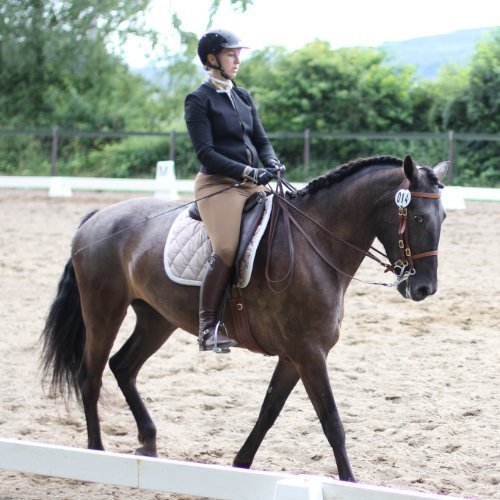
Aus 2 mach 4 – Mögliche Zügelführungen für Kandare und Unterlegtrense
Durch die unterschiedliche Wirkungsweise von Trense und Kandare muss auch die Zügelführung unterschiedlich gehandhabt werden. Anstatt beide Gebisse mit derselben Anlehnung, sowie Art und Weise zu verwenden, muss hier differenziert werden. Besonders beim einseitigen Zug drückt die Stange auf der einen Seite auf den Unterkiefer und gleichzeitig auf der anderen Seite gegen den Oberkiefer. Das Pferd kann verwirrt werden, was Du unbedingt vermeiden solltest.
Dies gilt besonders bei der heute üblichen Führung mit geteilten Zügeln. Dabei liegen in jeder Hand je 2 Zügel (2:2) und sie sind regulär jeweils nur durch einen Finger voneinander getrennt. Eine Differenzierung ist somit kaum möglich und das unabhängige Benutzen der beiden Gebisse wird erschwert. Oft wird dann beim Biegen mit der Trense die Kandare mit angesprochen. Ebenso wie beim Parieren über die Kandare der Trensenzügel betätigt wird.
Bei den unterschiedlichen Varianten der Führung wirkt die Kandare auf verschiedene Arten.
2:2 Zügelführung – die moderne Variante
Der gekreuzte Zügel, die üblichste Form
In den Reitbahnen sieht man am häufigsten die Führung mit gekreuzten Zügeln. Dabei wird der Trensenzügel klassisch zwischen Ring- und kleinem Finger gehalten. Der Kandarenzügel kreuzt den Trensenzügel innen von unten nach oben und verläuft zwischen Ring- und Mittelfinger. Diese Führung ist für das Pferd recht mild, da beim Parieren für gewöhnlich die Reiterhand nach unten gekippt wird. So entsteht mehr Druck auf das Trensengebiss als auf die Kandare.
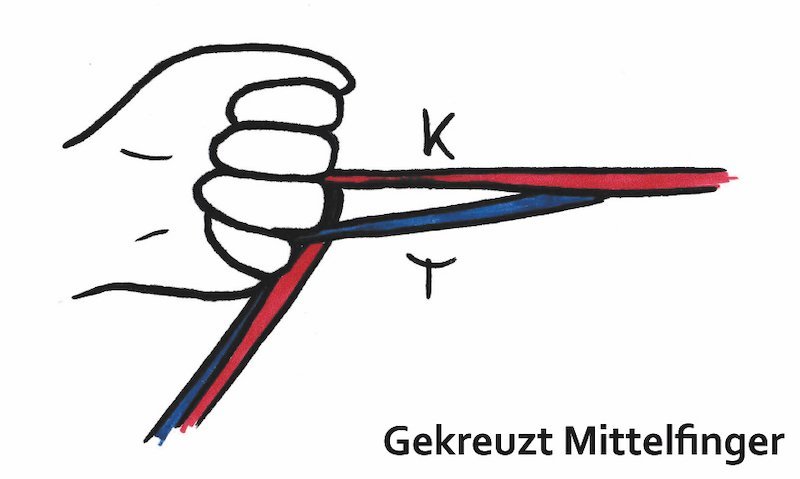
Hier besteht die Möglichkeit noch zu variieren indem der Kandarenzügel zwischen Mittel- und Zeigefinger geführt wird. Bei einer Parade entsteht kaum Druck auf die Stange.
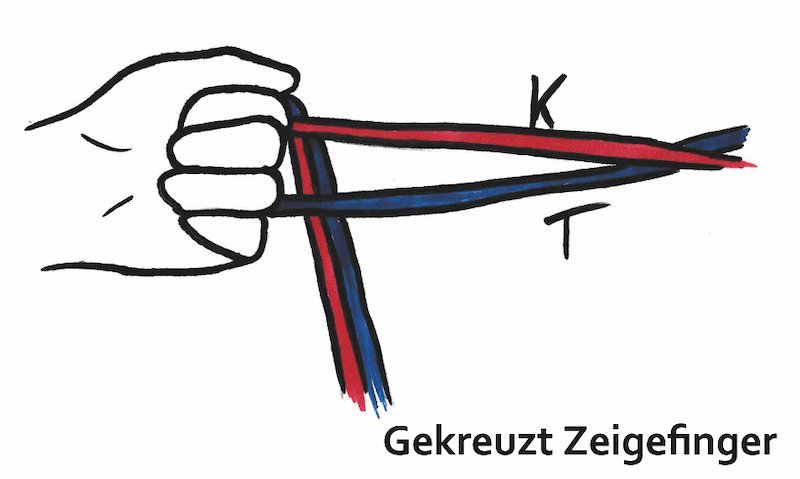
Der parallele Zügel
Der Trensenzügel wird wie gewohnt aufgenommen. Der Kandarenzügel wird unterhalb des kleinen Fingers in die Faust hineingeführt. Die Zügelpaare laufen parallel und kreuzen sich nicht. Die Wirkung der Kandare wird so verschärft.
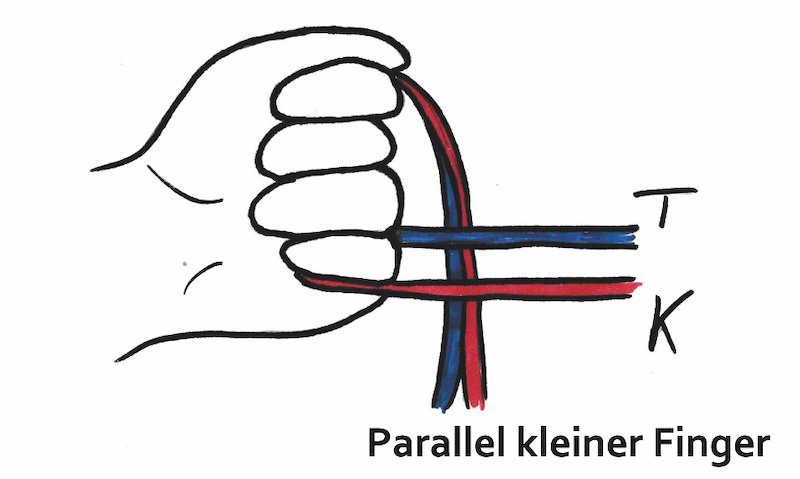
Auch hier gibt es eine Variation: Der Trensenzügel wird von oben nach unten durch die Faust geführt, der Kandarenzügel verläuft von unten nach oben. Du solltest wissen, dass bei dieser Führung eine Parade sehr scharf auf die Kandare wirkt, jedoch kannst du so die Parade für Trense und Kandare trennen.
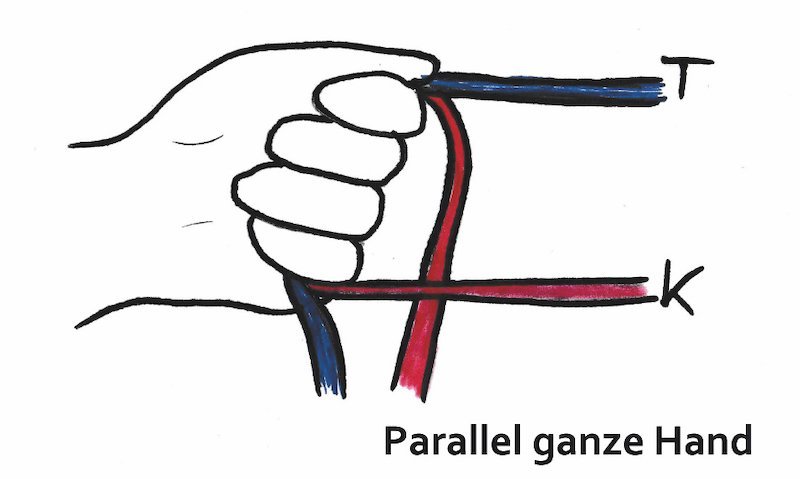
3:1 Zügelführung – die klassische Variante
Beschäftigt man sich mit den Lehren der alten Reitmeister, so stößt man auf die Meinung, dass ein ungebrochenes Mundstück nur dann richtig eingesetzt werden kann, wenn der Kandarenzügel einhändig geführt wird (3:1). In der modernen Reiterei ist diese Haltung kaum noch zu finden.
Der Trensenzügel wird klassisch beidhändig aufgenommen. Der Kandarenzügel jedoch wird einhändig geführt. Die Zügel werden innerhalb des Trensenzügel nach oben gekreuzt und laufen in einer Hand deiner Wahl (meist die Rechte) zusammen.
Der Kandarenzügel der „Kandaren-Hand“ läuft zwischen Ring- und Mittelfinger hindurch. Der 2. Kandarenzügel wird zwischen Mittel- und Zeigefinger geführt. So laufen ein Trensenzügel und beide Kandarenzügel in einer Hand zusammen und in der anderen Hand befindet sich der andere Trensenzügel.
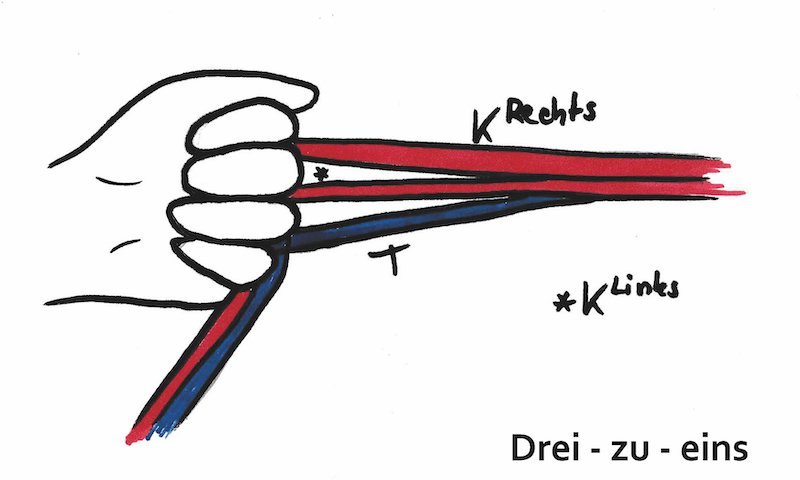
Diese Führung kann zum Versammeln und Aufrichten des Pferdes führen, ohne dass sie zur Lenkung eingesetzt wird. Bei ungeübten Reiter*innen besteht jedoch die Gefahr, dass die Koordination der Hilfengebung erschwert wird und die Zügel können leicht durcheinandergeraten.
Du solltest die Zügelführung nach dem gewünschten Zweck wählen. Die Differenzierung ist schließlich wichtig, um an das angestrebte Ziel zu gelangen.

Sei Dir jedoch zu jeder Zeit bewusst, welche Wirkung die Kandare im Maul Deines Pferdes hat und welcher Schaden bei falschem Gebrauch entstehen kann. Viele Pferde zeigen ihr Unwohlsein kaum und die kleinen Signale, die sie geben, werden leicht übersehen. Sieh genau hin. Unterstelle Deinem Pferd nicht, dass es sich aus Unlust und Faulheit sträubt. Gib ihm Zeit, die neuen Gegebenheiten kennenzulernen. Dann werdet ihr als Team auch weiterhin viel Freude an der gemeinsamen Arbeit haben.
Du bist noch auf der Suche nach der richtigen Ausrüstung? Entdecke Kandarenzäume, Stangengebisse und gebrochene Gebisse von Picadera.
Tipps aus der Picadera Community
